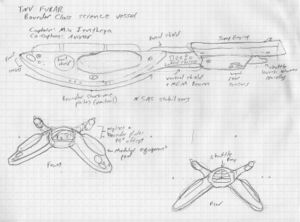Bounder Class
Defining Characteristics
- Rapid Short Range Jump Engine
- Most Tak'nhetian jump engines use long range folding technology. The downside of this technology included high energy cost and long charging times for more distant jumps. The single jump system also makes it easier to track a ship after it jumps.
- To address these issues, the bounder class uses a very short hop engine system that can charge in less than 2 minutes compared to tens of minutes for larger systems. Much of the jump boost speed comes from the novel addition to the engines known as the Bouncer Recoils Recovery System
- Bounder Recoil Recovery System
- Bounder class craft fly with their noses down nacelles up. This provides excellent exposure along the bottom of the ship where the recoil recovery system is mounted. When a jump gate collapses, it release a large burst of energy. The recovery system harnesses this energy and shunts it back into the engines. The net effect is an engin system that can make multiple short hops on a millisecond scale between jumps. While no single jump is much compared to older engines, the cycle time makes the Bounder class faster and more efficient that any other available system.
- Unfortunately the bounder systems are not yet available for capital class vessels and are still in testing in other classes of ship.
- Advanced Scientific and Engineering Payloads
- Bounder class vessels do not carry weapons as part of the Tak'Nhetian-Hycyanth Treaty. Instead of weapons, they carry the best scanners, constructors, and medical system that the fleet can offer. Bounders are few at present, but they are expected to expand now that the tragedies of the past have been reconciled. The vision for the Bounder class is deep space exploration and diplomatic contact as well as colony support.
TNV Bounder
The first and defining vessel was the TNV Bounder from which the class gets its name. The TNV Bounder was a heavy engines test rig with sufficient medical and support staff to handle most emergencies. After a dozen successful hop tests, Bounder was slated to make a speed run to test the engine limits.
Ten minutes into the test, monitoring vessels picked up a distress call halfway down the course. What they found was nothing short of terrifying. One nacelle was missing and the hull looked like pulled taffy on the starboard side. Crewmen were found dead and others were found partially alive but embedded in walls. Crewmen were recovered as fast as possible, but the death toll was nearly 50% if the missing were counted as dead.
Analysis of the Bounder's black box revealed that the nacelle struck an uncharted mass mid-jump that caused the ship to spine. It entered the next gate, which was already open, sideways causing a phase polarization along the distorted field lines of the remaining engine. The gate collapsed on top of the ship and swept many of the crew into places unknown. The Bounder class remained shelved afterwards.
Crew Rescue
The remaining crew would not be rescued until a second, much more advanced, Bounder class vessel named FUBAR was launched. Co-captains Mia and Avinar established a new method of course correction and compensation that once again made the class viable. Moving back and forth in time, at times without permission, she collected data sufficient to rescue the remaining crew without causing a paradox. Along with a foreigner named Kyizl, they managed to rescue the remaining live crew and confirm the final fate of four missing engineers.
=Second Launch
With the remainder of the crew recovered, Bounder was rebuilt using the Fubar modifications. While Mia's matye Geet, one of the original engineers, was not among those saved, she was convinced to fly with Bounder on their second launch. Bounder and Fubar made ceremonial stops to the site of the accident where they erected a memorial to the lost using the MEM beam constructors. Crewmen all left something personal behind in memory of the fallen before leaving, symbolizing their meed and attempt to move on after the loss of loved ones. The site remains a mandatory stop for new spacecraft engineers as a reminder of the dangers of their work.
TNV Fubar
Named in the theater convention of fooling malicious spirits with contradictory names, Fucked Up Beyond All Repair seemed to ward itself from proverbial gremlins with its name alone. Dedicated more to deep space exploration and medical advancements, Fubar was build to carry less crew and more equipment than the original class designs. It also bears a quantum mechanical manipulation systems know as Size Adjustment System or SAS. Mia a surgeon by trade, build the vessel with the ability to shrink to micrometer scale that renders many of its engineering tools into microsurgery systems.
Fubar remains in operation serving as medical escort, scouting, Her primary mission is exploration, but she has also been allowed limited time travel after some of her unauthorized trips yielded safe and worthwhile results including the recovery of many missing crew members of the Bounder.

